Cross-Media Transcription as Composition
A growing number of composers who work with both electroacoustic and acoustic means are developing strategies toward mimicking the compositional processes from one medium to the other. One can discover an especially clear manifestation of these efforts in works where a large part of the compositional form was generated by transcribing an existing work in another medium. In particular, there is a recent proliferation of composers who have written acousmatic works and have subsequently created acoustic (instrumental and/or vocal) works derived from the musical form and materials of their antecedent electroacoustic sources. The inverse is also possible, whereby new electroacoustic works are developed from acoustic compositional material.
While we may consider such exchanges conceptually similar to the idea of a musical “arrangement”, the translation between media stretches the notion, and the resultant works’ semblance to their source may only be nominal. Such examples nonetheless provide a fascinating example of cross-media exchange in composer’s compositional process, opening new ways of generating musical material, creating links between separate works and prompting interesting theoretical questions.
I will attempt to highlight some of these issues and questions through a discussion of several works by composers living in Canada, each of whom I interviewed about their compositional process in generating these works. I will discuss several inter-related works by three composers: Philippe Leroux’s M (1997, for 2 pianos, 2 percussion and electronics), M.É. (1998, acousmatic), m’M (2003, for orchestra), Pour que les êtres ne soient pas traités comme des marchandises (2004, for 12 voices, orchestra and electronics), Pourquoi (2009, 4 voices and orchestra) and AMA (2009, solo piano); Robert Normandeau’s Le renard et la rose (1995, acousmatic) and Baobabs (2012–13, for 6 percussionists, 4 singers and electronics); and Gordon Fitzell’s violence (2001, for chamber ensemble) and Evanescence (2001/2006, for chamber ensemble and electronics).
Following, I will briefly present some of my own work in the area, discussing the works Isomorphic, Isomorph, and Isomorphia (2012–14, acousmatic, orchestra, and orchestra + electronics, respectively), as well as IF:IFF (2014, chamber ensemble and electronics), Empties-Impetus (2015, acousmatic) and pre-echo (after empties) [2015–16, amplified string quartet and found objects].
Through this survey, I hope to highlight several different compositional approaches to the idea of cross-media transcription, addressing software-assisted and intuitive approaches. As the issues emerge in the works, I will discuss the ways in which the transcription process can affect the development of musical structure both intertextually (between works) and infratextually (within works), the tensions between different conceptualizations of music associated with different media, the parameterization of musical material, the ontology of musical works, performative dimensions of composition, the acousmatic listening situation and the influence of performance contexts on musical discourse.
Background
From the beginnings of electroacoustic music, many composers have worked across acoustic and electroacoustic media and found different ways of cross-pollinating their work over the two media, especially through ways of composing instrumental music inspired by or in imitation of electroacoustic processes. There are many such composers, but some familiar examples include Edgard Varèse, György Ligeti, Gérard Grisey and Helmut Lachenmann. An extensive and illustrative documentation of these ideas in the work of composer Ivo Malec is available in Martial Robert’s 2005 book, Ivo Malec et son studio instrumental. Throughout, Robert details the notion of an “instrumental studio”, a proposed conceptual equivalent in instrumental composition to the various editing, mixing and signal processing techniques associated with an electroacoustic sound studio. This text and others provide detailed accounts of the ways individual cross-media techniques have informed compositional practice, though some composers have applied these same ideas to larger-scale form, including transcriptions of entire works.
The first clear example (of which I am aware) of a composer deriving entire parallel works across instrumental and electroacoustic media is Iannis Xenakis’ Analogique A et B for nine string instruments and tape (1958–59). Analogique A (1958) existed first as an instrumental work and Analogique B, an electroacoustic work recorded on tape, was composed the following year. Constructed from sinusoidal sounds, the work was developed using the same mathematical processes that governed the form of Analogique A. Individually the works may be considered “two separate manifestations of the same design” (Di Scipio 2006, 1). Though the works had been realized individually until 1960, Xenakis chose to combine them into a single work in which the two parts are overlaid (Analogique A et B). Though the aural result could be similar, Xenakis’ approach to composing these works differs from the more recent works I will discuss, as both works were derived independently from one extra-musical model, rather than one work itself acting as a model for the composition of another. The works likewise do not exhibit the same kind of independence from one another, at least in the eyes of the composer and musicologists. The combined work Analogique A et B was Xenakis’ “preferred option” for performance (Harley 2004, 23) and the works have even been described as “indissociable” (Donin 2012).
Contemporary Efforts in Canada
In recent years, efforts toward cross-media transcription have proliferated, and numerous examples can be found in the work of composers living in Québec and elsewhere in Canada.
Philippe Leroux
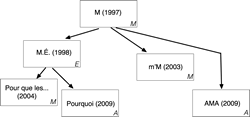
Philippe Leroux is a composer originally from France, now living in Montréal. He worked at both the Groupe de Recherches Musicales (INA-GRM) and the Institut de Recherche et Coordination Acoustique/Musique (IRCAM) in Paris, two institutions with a shared interest in music technology, but with historically opposite points of view, and indeed a degree of “antagonism” toward one another (Born 1995, 77). Perhaps owing to this, Leroux is somewhat rare among composers of his generation in his equally strong background and practice in both acousmatic and instrumental compositional idioms. Within his diverse catalogue are countless links between works; self-quotation characterizes a substantial portion of his output. A well-documented example is in the link between Voi(rex) (2001) and Apocalypsis (2005–06) [Donin and Theureau 2008]. While certain groups of works from among Leroux’s catalogue blur the boundaries of arrangement, transcription and composition, the most striking examples for comparison may be found in cases where works across electroacoustic and acoustic media resemble one another.
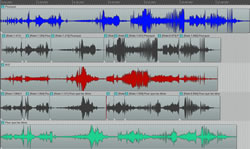
The works M (1997, for 2 pianos, 2 percussion and electronics), M.É. (1998, acousmatic), m’M (2003, for orchestra), Pour que les êtres ne soient pas traités comme des marchandises (2004, for 12 voices, orchestra and electronics), Pourquoi (2009, for 4 voices and orchestra) and AMA (2009, for solo piano) form a kind of genealogy of interrelated materials and structural similarities (Fig. 1). The mixed chamber work M acts as the original seed of material for this group of works, though the proliferation of changes and new compositional material marks each work with a significantly distinct identity. M was followed by the acousmatic work M.É., though the two are linked only by a few sounds in common (triggered electroacoustic samples in M and the electronic material in M.É.) [Leroux 2015].
A more significant relationship exists between M.É. and the two closely related vocal-orchestral works Pour que les êtres ne soient pas traités comme des marchandises and Pourquoi (Fig. 2). Each of these works derives their form and constituent sounds from a close transcription of the entire work M.É. As a point of departure toward this end, Leroux began his composition of the instrumental works through a thorough spectral analysis of the acousmatic work, using the software AudioSculpt and OpenMusic. The software-assisted approach presented limitations, however, where the results did not correspond to Leroux’s perception of the work, and so his own intuitive auditory analysis guided the compositional process throughout (Ibid.).
Sound-Based and Note-Based Tensions
The conceptual concerns and musical material of M.É. are ripe for cross-media transcription. In Leroux’s programme note, he situates the work’s goal as an attempt to establish a continuity between sound material and more abstract writing (Leroux 1998b). One may precisely associate the former end of this spectrum with the typical concerns of acousmatic music and the latter with those of instrumental music. In one case, there is a concern for the texture of sounds, energy and timbre profiles, and in the other for melody and rhythm. These poles align with a distinction Leigh Landy has proposed between “sound-based” and “note-based” music (Landy 2007, 17). Leroux distinguishes the two concerns as a comparison not merely between different kinds of musicality, but also between two different kinds of listening (Leroux 1998b). He identifies the work within his artistic development as part of a period where much of his work was centred around the idea of continuous transformation processes (Leroux 2015). There are many examples of continual changes of pitch, acceleration of tempo, compression/expansion of spectrum, gradual phasing, etc., that emblematize this notion within the various musical trajectories of the work. However, perhaps the most ambitious transformation process of the work is indeed this attempt at establishing a continuum between different conceptions of music. The work is then the site of an exchange between two different sides of Leroux’s compositional practice, though it “takes place” in one medium.
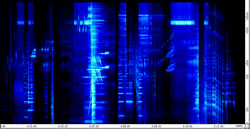
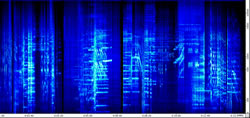
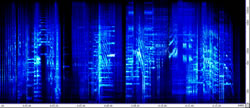
Because the musical concerns of the acousmatic work M.É. overlap considerably with those of instrumental music, Leroux immediately considered that the work could be realized in an instrumental version (Ibid.). As he composed the work Pour que les êtres ne soient pas traités comme des marchandises (hereafter shortened to Pour que les êtres…) he endeavoured to remain very close to the formal organization of M.É., though for various reasons (practical, musical, acoustic, etc.) different sections of the transcribed work resulted in different durations or prolongations of material (and this of course can vary in performance of the works).
The later work Pourquoi shares substantial written material with Pour que les êtres… and therefore has a similar relationship to M.É. but its different instrumentation results in a significantly different work. Especially, the presence of an electronic part in Pour que les êtres… — consisting of sound files directly drawn from M.É. — makes concrete the relationship between the acousmatic and instrumental work, drawing attention to the cross-media exchange. Further, the larger vocal ensemble in Pour que les êtres… blends more considerably with the abstract aural texture of the instruments and electronics, whereas the four distinct vocal parts in Pourquoi assert themselves as aurally dominant and the work adopts a direct, human quality. 1[1. At least, this distinction is clear to me in listening to the recordings of the works that informed my analysis (Leroux 2004; Leroux 2010).] Both works feature a part for electric guitar, which helps establish a certain degree of timbral similarity between the instrumental works and the electroacoustic processing heard in M.É. A spectrograph comparison of the three works reveals significant similarities and clearly illustrates the same continual pitch transformations heard in each, as well as the expectedly noisier spectra of the recorded instrumental works, contrasted with the pure electroacoustic (often synthesized) sound of M.É. (Figs. 3–5).
Intertextuality and “Sound” As Parameter
The relationships between Leroux’s works, especially those linked through transcription processes, implies a degree of “intertextuality”. The term, coined by the philosopher Julia Kristeva, is commonly used in literary theory to refer to:
[T]he “literary word” as an intersection of textual surfaces rather than a point (a fixed meaning), as a dialogue among several writings: that of the writer, the addressee (or the character) and the contemporary or earlier cultural context. (Kristeva 1991, 36)
Her concept of intertextuality can easily be translated to be applied to musical works, however, as one can understand a musical work not only by its self-contained individual identity, but also by its relationships to other works and its cultural contexts. This is true of any artwork, but becomes particularly evident in cases of (self-)quotation and (self-)transcription, as we see between M.É., Pour que les êtres… and Pourquoi. While in isolation each is a complete and satisfying musical work, the comparison between them can enrich our understanding and generate new ways of listening to and thinking about the works. In the same way that James Joyce’s Ulysses can certainly be read and appreciated on its own, it becomes a deeper work through its relationship to Homer’s The Odyssey and Joyce’s own The Portrait of the Artist as a Young Man, Leroux’s works inform one another and benefit from an examination of their relationships. The cross-media exchange between M.É. and its offspring bring this into relief. It is difficult to consider either of the instrumental works as simply “a version” of M.É. because the resultant sound and listening experience is so different. The translation does not give us a complete understanding of the original (no translation does) and indeed the differences become a point of musical interest in comparing the works. At the same time, it is not satisfying to consider M.É. as “required reading” for the newer works, nor in my opinion would the didactic exercise of playing the three works in sequence on a concert programme be an ideal way to hear and contemplate the works, either as texts-in-themselves or as intertexts.
Before the composition of Pour que les êtres… and Pourquoi, Leroux turned to the original composition that seeded some material for M.É., M, as part of another intertextual compositional exchange. The compositional process behind m’M (2003) for orchestra provides a contrasting example to the more extreme cross-media conversion between M.É. and its two offspring. Because the general pitch and duration information remained similar between the instrumental writing in M and m’M, the more significant compositional work occurred at the level of timbre, where certain sounds had to be completely re-invented (such as noise-based sounds, glissandi, or sounds with radically different morphology) [Leroux 2015]. Because this work moved from the more limited timbre-space (in the instrumental part) of piano and percussion in M to a large orchestra in m’M, the compositional process allowed for a certain expansion and elaboration of the source material. The converse may be said of AMA (2009) for solo piano, involving a kind of distillation or quantization of the sounds from M into a significantly limited sound world.
The exchange between works across media, and even through different constraints within the single medium of acoustic written music, highlights the timbral dimension of each work. Comparing translated words in language can have a similar effect: for example, considering the translations “Butterfly” (English), “Papillon” (French), “Mariposa” (Spanish) and “Schmetterling” (German) together draws attention to the sound of the words. Speaking generally about the process of transcribing an existing work into a new one, Leroux considers this manner of composition as an opportunity to focus as closely as possible on the parameter of “sound” alone (Ibid.). In a certain sense, other musical parameters (durations, pitches, dynamics, spectral density) remain more closely related between the original work and the transcription, and so aspects of timbre and orchestration become the central focus of the compositional effort. Naturally all aspects of the musical result are affected by the process, but those elements that remain similar between works draw attention to the different qualities of sound across media. It is clear from listening to the different works (and also from the way in which they are presented and entitled) that despite their close relationships they exist as complete, independent works, extending beyond the traditional notion of arrangement. Nonetheless, Leroux is interested in the links between the works and the “clues” for listeners and musicologists (sometimes as simple as a single shared letter in the titles — “M”) that connect them (Ibid.).
Robert Normandeau
Robert Normandeau is a Québecois composer living in Montréal whose principal output is acousmatic music. While he has several works in his catalogue for a solo instrument and electronics, an interesting outlier is the work Baobabs (2012–13) for a large chamber ensemble and electronics. Normandeau was approached by Fabrice Marandola, the artistic director of the Montréal-based percussion ensemble Sixtrum to create a new work based on his existing acousmatic work Le renard et la rose (1995). The new work takes the form of a mixed piece for four singers, six percussionists and electronics, and is in effect a transcription, or “adaptation”, of the antecedent work (Normandeau 2013b).

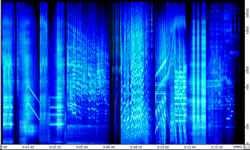
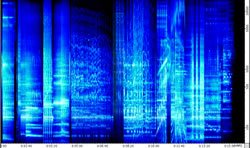
Le renard et la rose has many existing intertextual links, and so the addition of the adaptation Baobabs extends and adds another dimension to its rich genealogy. Some of its musical material is derived from existing compositional work by Normandeau that was created for a radio adaptation of Antoine de Saint-Exupéry’s Le Petit Prince, produced by Odile Magnan for Radio-Canada in 1994 (Ibid.). Baobabs’ title is then a trace through this genealogy, referencing the baobab plants that occupy a central image in the Saint-Exupéry novella. 2[2. Le renard et la rose also refers to significant images in the text: the fox and the rose.] The other source material in Le renard et la rose — the human voice — highlights its other intertextual links, as it is situated in a cycle of acousmatic works by Normandeau, Onomatopées (1991–2011), wherein each work focuses on the voice as material, viewed through the lens of different stages in a human life. Le renard et la rose, the third work of the cycle, examines adulthood. Officially, the cycle includes four works, the other three being Éclats de voix (1991), Spleen (1993) and Palimpseste (2005/11). Each of these works is subdivided into five sections, titled as dyads of emotions and musical parameters. 3[3. Interestingly, the musical parameters are the same and presented in the same order across the five works: Rhythm, Timbre, Dynamics, Space, and Texture. The emotions change, with the exception of the third movement, which in all four works is titled “Colère et dynamique” (“Anger and Dynamics”).] Baobabs preserves this structure, and through its relationship with Le renard et la rose, it may be considered an “honorary member” of the Onomatopées cycle, or as Normandeau describes it, “the fifth version of a single idea” (Normandeau 2015). 4[4. The “extended cycle” could be expanded even further, as the impulse to compose Éclats de voix came from an earlier, shorter work, Bédé (1990) which shares its sound sources (Normandeau, in Ogborn 2009). This work could then be considered a kind of “prequel” to the cycle proper.]
The high degree of structural similarity in the Onomatopées works is indebted to Normandeau’s compositional process and technical means in realising the works.
After the completion of [Éclats de voix], I realized that it was the first time for me, as well as in the history of electroacoustic music, that we were able not only to keep a trace of our recorded and treated sounds, but also to keep the gestures that were used to make them. I had a sampler with CD-quality sound (Akai S-1000) controlled by MIDI software (Master Tracks Pro), and the music was recorded on an analog 16-track recorder. Because of this setup, it was possible to keep a trace of everything that was done in the studio.
And so I decided to compose a cycle based on the same timeline as Éclats de voix. I removed the sounds used in that piece and I recorded the same (or almost the same) onomatopoeias, but with a group of four teenage boys. As one can imagine, the energy was not the same! I composed a new work called Spleen, based on the same timeline, but with different sound material. Then two years later I did the same thing again with Le renard et la rose, with adult voices. And ten years later I completed the cycle, with the voices of older people, in the fourth and final piece of the cycle, Palimpseste. (Normandeau, in Ogborn 2009)
In each piece, then, the timing of onsets of samples, the repetitions of samples, etc. is preserved as a structural framework. The samples themselves change between pieces, and so the qualities of the sounds chosen dramatically alter the resultant sound and, to a certain degree, the perceptible structure of the work. The title of the fourth work in the cycle, Palimpseste, meaning a written document where original writing has been erased to be reused, alludes rather clearly to this process.
This manner of composing afforded Normandeau a substantial data set concerning the structural aspects of the works, and so despite the cross-media aspect of the compositional process behind Baobabs, an existing framework was preserved from the composition of Le renard et la rose that might otherwise have required an extensive post-hoc analysis. Nonetheless, because the work was composed in 1995 using now-old hardware and discontinued software (Studio Vision), the composition of Baobabs began with an extensive reconstruction of Le renard et la rose (Normandeau 2015). After its constituent samples were extracted, they were analysed in the software Melodyne to extract pitch information and exported as MIDI data to be used in developing the score. The sampler-based composition method was employed further in the transcription process, as the use of sampled percussion instrument recordings in the place of the original vocal sounds from Le renard et la rose assisted in choosing the orchestration of the percussion writing in Baobabs (Ibid.). Though certain constraints had to be made given the limitations of the instrumental and vocal sounds possible and to ensure performability (Ibid.), the resultant structural proximity of Baobabs to its forbearer is striking, revealing the careful and detailed temporal similarity afforded by Normandeau’s approach to the transcription (Figs. 6–8).
The Grain of the Voice and Musical Ontology
An important relationship to note between Le renard et la rose and Baobabs is the centrality of the human voice as material and its affect on the musical result of the two different works. As Roland Barthes famously argued in his essay “The Grain of the Voice,” the quality of an individual voice in a work can be a defining feature (Barthes 1977). We saw this also in the comparison between Leroux’s Pour que les êtres… and Pourquoi (in these pieces the number of voices and manner of amplification also plays a significant role). To a certain extent, the Onomatopées cycle is about this issue of the grain of the voice: while many of the musical and structural parameters remain similar across the works, the vocal sounds themselves change, as they have been recorded from different voices. Normandeau has commented on the impact of the individual quality of the sound sources on the compositional process and resultant musical differences:
The use of rhythm is not so obvious in Éclats de voix, but in Spleen, because the boys [whose voices were recorded for the piece’s material] were so much more energetic and rhythmic in the studio, I decided to push the boundaries a little bit: the sound is raw, the rhythms are more evident, more “in the face.” In Le renard et la rose, the boundaries are pushed further again, with minimal sound treatments. (Normandeau, in Ogborn 2009)
This highlights an interesting and important issue in the idea of cross-media transcription. While recorded media preserve a particular sound in a particular way, the abstract tool of musical notation provides only a general instruction about the resultant sound (which may vary between performers and performances). Nowhere is this more evident than in the human voice. Between Le renard et la rose and Baobabs, then, a significant delineation is the difference between specific voices from a particular place and time, and more abstract, generalizable vocal instructions. The very first sound of each work presents an ideal example. In Le renard et la rose a very unique and striking burst of laughter, punctuated by a percussive dry wheeze, opens the work. The score for Baobabs begins with three measures of “rires” (laughs) for the four singers (Normandeau 2013a). We therefore have a comparison between the definite — a (specific) laugh — and the infinitive — to laugh. It may have been possible to specify the quality of laughter further in the score with descriptive words, rhythmic or graphical notation, but the choice to open the work with the abstract, broad instruction mirrors the concept of the Onomatopées cycle as a single structural idea manifested in different musical results through different qualities of voice. The score of Baobabs becomes a “meta-composition” in the same way as Normandeau’s sampler data, which can be refreshed with new sound material. In a sense, each and every performance of Baobabs becomes a new work in the “extended cycle”. The recording available by the ensemble that premiered the work reveals a very different quality of laugh than we hear in Le renard et la rose (Normandeau 2014), and future performances may yield still different results.
The difference between definite and infinitive sound between these two works opens a considerable ontological question about the individuality of “a musical work”, as is implicit in the process of cross-media transcription. While traditional views of acoustic music identify the musical work as contained in the score or in the performance (Goodman 1976, 117–118; Wollheim 1980, 64–72) this “Musical Platonism” has been roundly criticized (Predelli 1995, 339), as has the notion of equivalency between “the work” and the “musical score” (Adorno 1981, 144). Acousmatic music does not escape this problem, though in this medium it is perhaps more subtle (perhaps even enhancing the temptation toward Musical Platonism). The physical document (whether it be magnetic tape or a sound file on a computer) remains several steps removed from the heard experience of the music, though there are perhaps fewer steps than in written acoustic music. The quality and number of loudspeakers, their disposition in space, the quality of the acoustic in the room, the possibility of live diffusion, etc., all contribute to aspects of the music-as-heard that cannot be reduced to its physical source. Schaeffer’s complex antithetical definition of the “sound object” (it is neither the acoustician’s “signal”, the magnetic tape on which it is recorded, the instrument that plays, nor the subjective experience of the sound [Schaeffer 1966, 95]) may equally extend (with some modifications) to ontological questions about entire works of electroacoustic music. The question of musical ontology is therefore complex across media and I do not mean to answer these perennial questions, only to show the relationship between them and cross-media transcription. The tightly woven relationships between all of the works in Normandeau’s Onomatopées cycle and Baobabs afford different conceptualizations: each work is as much its own text as is each a kind of performance of a single work, Onomatopées. Within Baobabs we may entertain the idea of each performance as an independent work, as well as each being a “performance of a performance” of Onomatopées — echoing Normandeau’s description of the cycle as a “single idea” (Normandeau 2015). The performativity of Baobabs thereby highlights the performance behind Éclats de voix, Spleen, Le renard et la rose and Palimpseste.
Lifting Pythagoras’ Veil
The performative dimension of Baobabs is nonetheless distinct in that the performance is visible and possible to witness in real time. This is of course the distinction presented by acousmatic music where, following the description of Pythagoras giving lectures behind a veil so that visual perception may not influence the content of his words, the physical source of the music-as-heard is hidden (Schaeffer 1966, 91). A consequence of transcribing an acousmatic work into an acoustic one is the lifting of this veil; a significant difference between the works becomes the visual performative element. That aspect of the work necessarily impacts its potential meaning and, through its intertextual link, that of its antecedent acousmatic source. This is not simply limited to instances where the sound sources of an acousmatic work are similar to the live sources of its transcription (as in the voices as source in both Le renard et la rose and Baobabs); the introduction of any physical gesture can forge a new meaning for the sound to which it may be related (as in the percussion writing in Baobabs reflecting vocal sources in Le renard et la rose). Alexa Woloshyn has analysed the works in the Onomatopées cycle according to the conspicuousness of vocal sounds (Woloshyn 2011), identifying structural functions of this aspect in the music. Of course, in performance Baobabs elevates this conspicuousness to an extreme and so its relationship with the structure of the work also changes. Normandeau is generally not shy about the referential (and imagined visual) dimensions of his music (Normandeau 1993) and his description of Baobabs indicates an interest and sensitivity toward this aspect as revealed through performance. Considering that the four works in Onomatopées link their vocal sources to a particular age in human life, Normandeau muses that while Baobabs was not composed similarly with a particular age in mind, the age of the performers on stage link it to the same “adult” quality as Le renard et la rose (Normandeau 2015).
Gordon Fitzell
Gordon Fitzell is a Manitoban composer living in Winnipeg whose catalogue includes instrumental, mixed, acousmatic and improvisatory music, as well as sound installations. A pair of his works forge a direct link between some of these different aspects of his practice: violence (2001) and Evanescence (2001/6), both commissioned by the Chicago-based ensemble eighth blackbird.
Though violence itself is a purely acoustic piece (scored for flute, clarinet in B-flat, percussion, piano, violin and cello), Fitzell has received comments that it (and other works of his) “sounds like acoustic electroacoustic music” (Fitzell 2015). Fitzell’s practice in acousmatic and other electroacoustic music certainly can be seen as influencing his instrumental writing, and many of the sounds in violence make sense as the result of “instrumental studio” practices (Robert 2005). Therefore, while Fitzell did not anticipate making a mixed adaptation of violence, when eighth blackbird asked him for such a work, he became interested in the idea, as it seemed like a natural extension of the compositional goals of the work (Fitzell 2015).
Evanescence, whose title comes from its relationship as a near-homophone to e-violence, the working title of the composition, was composed as a “rethinking” or even a “remix” of its source work (Ibid.). Nonetheless, one of Fitzell’s goals in composing the work was to create a “sufficiently different work… ideally something as good or better” (Ibid.). The instrumental parts of the scores for each work are very nearly identical, save for some extended durations of the material, especially to accommodate a two-minute long diminuendo (of violin and electronics) that gives Evanescence a significantly different ending from violence (Fitzell 2001 and 2006). The work instead distinguishes itself principally through the constant application of relatively heavy electronic processing to all of the instrumental parts. In addition to this, the electronic part consists of several triggered sound files and optional freely improvised (“subtle”) electronics (Fitzell 2006). Therefore, despite the nearly indistinguishable instrumental writing in both works, the aural result of Evanescence is significantly different, as every sound in the work is reshaped to a certain extent through the electronic media. Fitzell views the two works as “inextricably linked” but also “fully independent” (Fitzell 2015). Both works have been performed together in the context of a single concert, and have been recorded on the same album (Ibid.), suggesting a unique identity for both, despite their structural and performative similarity.
The live processing required to realize the work is described in general terms, but the specific implementation is at the discretion of the electronics performer, as is the optional component for an improvisatory element. This connects to another side of Fitzell’s compositional practice that centres around open scores and improvisation, and makes it so that each performance of Evanescence may be theoretically as different to one another as the work itself is to violence. Again, this example of cross-media exchange encourages questions about the ontology of a musical work.
Composing an electronic part to expand an existing self-contained and complete acoustic work was a matter of creating “illuminations and/or extensions of extant elements in the original piece,” thereby “[attaching] a new focal lens, or [applying] a filter — both literally/digitally and æsthetically/compositionally” (Ibid.). The choice of electronic processing was, to a certain extent, an effort to apply acoustically similar manipulations to instrumental playing techniques, such as noisy granulation to bowed scratch tone (Ibid.).
The process of creating a new work by adding a new electronic element to an existing instrumental composition may not be most precisely described as “cross-media transcription”, but the manner in which some of the electronic part was composed resembles the process of analyzing the sound from one media and attempting to realize it in another. All of the clearest examples of cross-media transcription discussed above have involved the realization of acoustic written music derived from an extant electroacoustic work, whereas the relationship between violence and Evanescence is something close to an example of the converse. Indeed, the first time I encountered the work was in a concert that I co-organized where Fitzell diffused a recording of Evanescence over a multi-channel array of loudspeakers as one might an acousmatic work, absent of any performative element. Because the work is so transformed by the electronic elements, it seems comfortably situated in such a context. However, while Fitzell has diffused the recording as an acousmatic piece “once or twice,” his preferred realization of the work is as a mixed piece with chamber ensemble and live electronics (Ibid.).
The notion of diffusing an (in this case, partly) instrumental work in an acousmatic context, of course, can be conceptualized as instrumental-to-acousmatic “transcription” — in this basic sense, should such a practice be applied to any acoustic work (and I do not think this is a common occurrence), it may be thought of as a new acousmatic piece of music. Since the medium does not imply a distillation or translation of the resultant sound of the work (as does the inverse practice of transcribing an instrumental work from an electroacoustic one), the idea of such a “transcription” that endeavours to capture as accurately as possible the aural result of its antecedent resembles much less composition than it does the recording of an instrumental performance. However, the manner in which Fitzell chose some of the electronic processing in Evanescence suggests a more interesting compositional path, where electronic sound was composed based on similar acoustic qualities rather than an exact reproduction. This manner of working could theoretically be used as the means of developing an entirely new electroacoustic work from an extant instrumental work, though I am not aware of any example to date. I have attempted something similar as part of the compositional process of sections of single works, including Isomorphic (2012–14) and IF:IFF (2014), which I will discuss in the following section.
An Auto-Ethnographic Analysis
In my own compositional practice, which includes acousmatic, mixed and instrumental music, as well as sound installations, cross-media transcription plays an important role in several works. Because the concept is deeply rooted in the compositional process, and I have fuller knowledge of my own process than of any other composer, I hope the reader will indulge a foray into auto-ethnographic analysis and appreciate it as a means to further discuss the conceptual implications of cross-media transcription and perhaps to yield some points of interest unique to the works I will present.
“Isomorph/ic/ia”
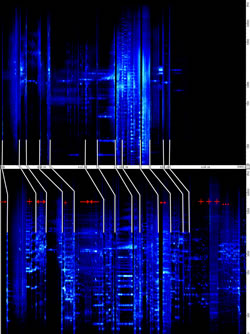
Isomorphic, Isomorph and Isomorphia (2012–14, acousmatic, for orchestra and for orchestra with electronics, respectively) comprise a triptych of works that share the same form (the meaning of the title[s]). The relationship between the three works is part of a broader aspect of my compositional practice that I have called mimetic instrumental resynthesis (O’Callaghan 2015a), where recorded environmental sound is transcribed for acoustic instruments. I have detailed aspects of this idea in several publications, and discussed the composition Isomorphia in this context extensively (O’Callaghan 2012, 2013a, 2014, 2015a). The pertinence of this triptych of works to the present discussion is that this technique was applied not only to generate material for an instrumental work, but also more broadly to match the form of an extant work. The more general technique of instrumental synthesis (Fineberg 2000, 85) can be observed in various forms as part of the compositional process of cross-media transcription in some of the works by Leroux and Normandeau, and in the works of mine I will discuss as well.
The compositional process of the Isomorph/ic/ia triptych was immensely intertwined, as was the manner of cross-media transcription. Roughly the first half of the acousmatic work, Isomorphic, was completed by 2012 and the work existed as a completed miniature in this state. The orchestral work Isomorph began as transcriptions of the acousmatic work, and the first half of this work was composed following the form of the Isomorphic miniature very closely, with the occasional injection of new material (Fig. 9). The completion of the work followed the more typical process of mimetic instrumental resynthesis (as used in other works of mine such as Iron Horses (2012) and For or From (2015), in which individual field recordings (not arranged in any particular compositional assembly) are analysed to generate new instrumental material. 5[5. Whether analyzing isolated field recordings or the composed acousmatic miniature, the transcription was assisted with software analysis using Orchidée, SPEAR, AudioSculpt, and OpenMusic, in combination with intuitive approaches.] Isomorph was completed in 2013 and immediately afterwards an electronic part was added to create Isomorphia. The electronics consist of triggered sound files adapted from Isomorphic and developed from the field recordings used to generate the later instrumental writing. They are always triggered to synchronize with the transcription point, blending and transforming the heard experience between the source electronic sounds and their instrumental imitations. The instrumental part of the scores for Isomorph and Isomorphia are identical. The two different pieces exist in order to provide a kind of aural counterfactual for the presence and absence of the source sounds, providing alternate modalities where the window into the work’s environmental-electroacoustic genesis is more or less transparent (Audio 1–3).
Finally, Isomorphic was completed the following year by developing the materials used in the electronic part of Isomorphia into the second half of the acousmatic work. Additionally, as some parts of Isomorphia feature purely acoustic extrapolations and developments of their electronic source sounds, the composition of the second part of Isomorphic took the form of a kind of cross-media transcription in which new acousmatic material was generated from scratch based on an analysis of the instrumental part of Isomorph/ia, especially in terms of following dynamics, spectral density, texture and the piece’s structure. For example, some of the contrapuntal instrumental textures in Isomorph/ia were imitated using convolution and delay lines in Isomorphic. In certain sections, however, the musical material was developed in significantly different ways in the latter half of the two works. Thus, the works preserve the same overall shape but some micro-level details differ significantly. The relationship between the three works is therefore complex and it is not possible to describe one as a transcription of the other, as cross-media transcriptive exchanges occurred between the works recursively during their overlapping compositional periods, including instrumental transcriptions of acousmatic material, and acousmatic imitations of instrumental material. The works then highlight the diversity of possible relationships in cross-media transcription.
“IF:IFF”
IF:IFF (2014, for 14 instruments and electronics) presents an example of infratextual cross-media transcription, meaning that within the work, one section is a transcription of another in a different medium. In this case, roughly the first two minutes of the instrumental writing in the work were used as the model for developing an electronic part that appears near the end of the work. This electronic part, consisting of fixed-media triggered sound files was composed before a performance or recording of its instrumental source, and so its development was based on an estimation of the resultant sound of the instrumental writing, and not an analysis of a recording (as was the case for the end of Isomorphic). These two parts of the work were the first sections composed, though they do not appear in sequence in the work: the later appearance of the electroacoustic transcription attempts to create a structural link between the beginning and end of the work, acting as a kind of “filtered memory” of the original sound (Audio 4–5). It was my goal to realize the electronic part from different sound sources than the instrumental part, but nonetheless observe the same structure and surface musical features of pitch, rhythm and spectral density. The single shared sound source is a struck D-flat crotale. In the instrumental part, this crotale pitch is played live and extended as downward glissandi in the strings. In the later electronic part, the crotale recording is extended by auto-convolution and dynamically pitch-shifted. This musical idea repeats throughout the section, and each time it is preceded by a percussive gesture: in the instrumental part this is achieved through struck shell and bamboo chimes — in the electronic part it is an assembly of manipulated recordings of glass breaking. The use of resonant filters on ambience recorded in a cathedral further served to mimic the harmonic structure of instrumental textures in the source material. And so, the work features an inner relationship between an instrumental-dominant section and a later electroacoustic-dominant section where the latter is an attempt to recreate the structure and basic musical features of the former with novel electroacoustic means.
“Empties-Impetus” (2015) and “pre-echo (after empties)” (2015–16)
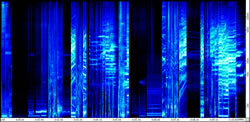
While the Isomorph/ic/ia triptych and IF:IFF feature complex exchanges between media within and between works, I have endeavoured recently to compose an instrumental work that closely and precisely imitates an existing acousmatic work of mine. Empties-Impetus (2015) is an acousmatic work that has its own intertextual links: it is the third work in a trilogy of acousmatic works centring around a musical instrument (or group of instruments) as source material, and has an optional performance modality where the work is partially diffused through speakers attached to or inside of the instruments in the concert hall (without performers). 6[6. The other two works are Objects-Interiors (2013) and Bodies-Soundings (2014). For more information on these works and the practice of instrument-diffusion, see the author’s article “Resounding but Not Sounding: Diffusing into interior spaces of instruments,” published in eContact! 17.3. (O’Callaghan 2015b).] A very small amount of self-quotation exists between the three works, where some sound materials and rhythmic structures were subtly inserted from other works in the trilogy.
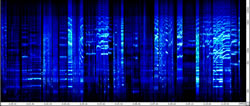
The instruments of concern in Empties-Impetus are those of the traditional string quartet and in performance the piece can be partly diffused through tactile transducers attached to each instrument. The bulk of the sound sources in the work are from these instruments, supplemented by several everyday objects and field recordings. Before composition began on the work, I planned to later transcribe it as an instrumental piece for a live string quartet with electronics. The planned manner of integrating the transcription with electronics is the result of a formal experiment for the composition of the acousmatic work: I would write the first and second halves of the 20-minute work such that they could be overlaid — that if one were to play the two halves at the same time, rhythmic and structural changes would align, and spectral and dynamic “holes” in one half would be filled by the other. This structure was imposed with the idea that the eventual transcription would synchronize with electronics adapted from the opposite half of the acousmatic work.
The occasion to write a string quartet quickly followed, for the Montréal-based Quatuor Bozzini. The resultant work, pre-echo (after empties) was composed in 2015–16 in the context of a two-part workshop, and so the first ten minutes (the first movement) of the work were transcribed as an acoustic piece, with electronics only in the form of amplification. After this stage of the project, I tested my plan to integrate electronics from the acousmatic work using a recording of the performance of the work for string quartet. The results were deeply unsatisfying! So, the eventual completed work abandoned this planned component, leaving the “structural overlap” formal strategy unapplied and now existing only as a relic of the compositional process and a means by which the form of each work achieves a kind of “inverted self- similarity”. The resultant two-movement work, then, emerged as a complete, linear transcription of the acousmatic work for amplified string quartet and found objects and was premiered in full on 5 February 2016 in Banchory, Scotland (Audio 6–9).
The transcription process of the work was a significantly more intuitive venture than previous efforts in Isomorph/ia. The partial-tracking spectral analysis software SPEAR was used as a guide to map pitches and durations, but all other compositional choices were made based on an intuitive aural analysis. I followed the structure of Empties-Impetus closely, only occasionally quantizing the rhythm and including fermatas to afford performability. A significant difference between the works, however, is one of scale: the acousmatic work is very densely layered in many sections, matching the forces of an immense string orchestra rather than a quartet (Fig. 10). The reduction of the material (especially in terms of texture, harmony and breadth of registers) into a significantly smaller scale was then a means to distil the work into its essential surface features: the outlines of forms with their fillings emptied (Fig. 11). At the same time, the intensity and density of writing for each of the four instrumental parts, magnified by amplification, gives the performance a feeling of the instruments “punching above their weight”. The reductive aspect of the transcription process was nonetheless an interesting compositional exercise for me as a means of analyzing the structure of Empties-Impetus. The composition pre-echo (after empties) then serves an additional role as a kind of analytical exegesis of its parent work, much as piano reductions are sometimes used as analytical tools for the study of orchestral works.
A significant conceptual concern of the work is the same “lifting of Pythagoras’ veil” that I discussed in the context of Normandeau’s Baobabs. The same concept can be applied to the performance modality of Empties-Impetus, for which the instruments of the string quartet are placed in the concert space, acting as visual reminders of the primary sound sources of the acousmatic piece. In pre-echo (after empties), this is of course more dramatic, as the sounds are re-coupled not only with the visual presence of their source, but also with the performance gesture of the musicians playing them. In some cases, this is indeed the same gesture used in generating the corresponding acousmatic material, especially in the case of the col legno battuto-tratto technique ubiquitous to the work, where the wood of the bow is first struck and then immediately drawn lengthwise across the hand-muted strings of the instrument. In other cases, the instrumental gesture used to produce the transcribed sound in pre-echo (after empties) is not at all similar to the corresponding source sound in Empties-Impetus, especially when the instrument is used to imitate a sound created from another source or heavily manipulated with electroacoustic processing.
Found Object Performance
pre-echo (after empties) does, however, forge links with other sound sources used in Empties-Impetus, as many of these sources used as material in the acousmatic work re-appear as performative objects in the acoustic work. Throughout, the musicians are occasionally asked to switch from playing their instruments to performing certain “found objects”: digging earth out of plastic pots with trowels, writing on paper (with various utensils), tearing sheets of paper, unravelling duct tape and clicking the rotary switch of a desk lamp. All of these performance actions, where they are indicated in the score, correspond to the original object and performance gesture used in recording sessions to generate material for the acousmatic work. And so, in addition to some of the string writing, the transcription from the acousmatic work into a performed work involves in many places a reenactment of the compositional process behind Empties-Impetus in real time. This is in a sense a manner of physicalizing the idea of the sound object 7[7. Thereby of course contradicting Schaeffer’s antithetical definition of the term (Schaeffer 1966, 95).] by performing a physical object in real time in a similar manner to the way a recording of such an object-performance would be assembled in an acousmatic work, an idea I have examined in previous works (most extensively in a 2012 work for amplified books and electronics, Reasons.).
The manner of performing the found objects was one aspect of the transcription process that changed during the process of working with the musicians. In particular, the indications for writing on paper were originally detailed rhythmic transcriptions of the recorded sounds of writing as they appear in Empties-Impetus. During rehearsals, the quartet and I decided that this was not the most naturalistic manner of performing writing! Except in one section where the pen strokes align exactly with performed material by the other instruments, the notation for writing-performance is now freer, including an instruction to write “a secret message to yourself.” To whatever degree it may impact the heard discourse of the work (I expect very little), this instruction is a conceptual link to the idea of specificity in the performance of the work, and the distinction between definite and infinitive sound (also previously discussed in the context of Normandeau’s Baobabs). While the recordings in the acousmatic work are specific to writing actions from a particular time and place (and of particular texts that are likely not identifiable by their pen strokes), the score’s instruction is a more abstract indication about the act of writing in general. In each performance, the musician makes the action concrete again, their specific pen strokes linked to a hidden text, likely distinct from the one used to record the acousmatic work. Similarly, the preparation of the work requires that the buckets used as performed objects be filled with dry earth from the same region as the performance site. Again, this is not likely to impact the acoustic result in an identifiable way. 8[8. Although I would love to meet the person who could identify the regional origins of dirt and sand by the sound of it being impacted by a trowel.] A significant consequence for me in all electroacoustic-to-instrumental transcription, but especially in these cases including found object performance, is the creation of a context where the musical instruments are situated as physical objects with a specific identity and history, rather than as deliverers of a purely abstract musical discourse removed from their physical presence. The choice to compare an electroacoustic sound to one reproduced live by an instrument may make the instrument conspicuous: the thought that “that sound was made by a cello” (for example) is more likely to occur to me than in most other contexts of acoustic music performance, where such a thought would be relatively unremarkable. Within the work pre-echo (after empties) the infratextual presence of found object performance alone asserts this conception (the evident objecthood of the everyday items “rubs off” on its instrumental neighbours), but the intertextual links in all the works discussed may provoke the same observation and affect our manner of listening.
Conclusion and Future Work
This survey of the idea of cross-media transcription as a means of composing new work, while non-exhaustive, illustrates the extreme diversity of approaches and some of the many conceptual issues the process may provoke. The discussion of works has centred around music by composers living in Canada, demonstrating the compositional method’s lively presence in the country’s artistic community. For my part, I intend to continue composing using the technique. Nearest on the horizon is a work for the sextet Standing Wave to premiere in Vancouver in April 2016, which will use as its starting point a transcription of my acousmatic work Objects-Interiors (2013). Rather than act as a direct transcription, I intend for the work to exist as a means to examine the idea of cross-media transcription as a performative act and as a site for memory — repeating and recording in real time transcriptive material in various stages of development, appropriating the performance as document and re-appropriating document as performance.
Bibliography
Adorno, Theodore. Prisms. Studies in Contemporary German Social Thought. Trans. Shierry Weber Nicholsen and Samuel Weber. Cambridge MA: The MIT Press, 1983.
Barthes, Roland. “The Grain of the Voice.” In Image, Music, Text. Trans. Stephen Heath. London: Fontana Press. 1977.
Born, Georgina. Rationalizing Culture: IRCAM, Boulez and the institutionalization of the musical avant-garde. Berkeley: University of California Press. 1995.
Di Scipio, Agostino. “Formalization and Intuition in Analogique A et B (with some remarks on the historical-mathematical sources of Xenakis).” Definitive Proceedings of the International Symposium Iannis Xenakis (Athens, Greece: University of Athens, 18–20 May 2005). http://www.iannis-xenakis.org/fxe/actus/symposium.html
Donin, Nicolas (Ed.). “Analogique A et B (1958–1959).” B.R.A.H.M.S. IRCAM, 2012. http://brahms.ircam.fr/works/work/12781
Donin, Nicolas and Jacques Theureau. “La coproduction des œuvres et de l’atelier par le compositeur (À partir d’une étude de l’activité créatrice de Philippe Leroux entre 2001 et 2006).” Circuit 18/1 (2008) “La fabrique des œuvres,” pp. 59–71.
Fineberg, Joshua. “Guide to the Basic Concepts and Techniques of Spectral Music.” Contemporary Music Review 19/2 (2000) “Spectral Music: Techniques, Aesthetics and Music,” pp. 81–113.
Fitzell, Gordon. violence. [Unpublished score] 2001.
_____. Evanescence. [Unpublished score] 2006.
_____. Magister Ludi. With Ensemble contemporain de Montréal. Cond. Veronique Lacroix. Toronto: Centrediscs (CMCCD 20414), 2014.
_____. Personal interview. 11 August 2015.
Goodman, Nelson. Languages of Art. Second edition. Indianapolis: Hackett, 1976.
Harley, James. Xenakis: His life in music. New York: Routledge. 2004.
Kristeva, Julia. “Word, Dialogue and Novel.” In The Kristeva Reader. Edited by Toril Moi. Trans. Alice Jardine, Thomas Gora and Léon S. Roudiez. Oxford: Wiley-Blackwell. 1991.
Landy, Leigh. Understanding the Art of Sound Organization. Cambridge MA: The MIT Press.
Leroux, Philippe. M.É. [Audio] 1998.
_____. M.É. Artsonores (INA-GRM). [Programme note] 1998. Available online at http://fresques.ina.fr/artsonores/fiche-media/InaGrm00040/philippe-leroux-m-e.html
_____. Pour que les êtres ne soient pas traités comme des marchandises. With Ensemble Vocal Musicatreize and the Orchestre Philharmonique de Nice. Cond. Lorraine Vaillancourt. Performance in the 2004 MANCA Festival “Les Grands Travaux” at the Nice Opéra on 5 November 2004.
_____. Pourquoi. With Catherine Dubosc, Elena Vassilieva, Marie Kobayashi and Ivan Ludlow, Orchestre National de Lorraine. Cond. Jacques Mercier. Performance at the Congresshalle in Saarbrücken (Germany) on 24 January 2010.
_____. Personal Interview. 16 July 2015.
Normandeau, Robert. “… et vers un cinéma pour l’oreille.” Circuit 4/1 & 2 (1993) “Électroacoustique-Québec: L’essor,” pp. 113–125.
_____. Le renard et la rose. On Figures. Montréal: empreintes DIGITALes (IMED 9944), 1999.
_____. Baobabs. [Unpublished score] 2013.
_____. Baobabs (2013). Programme note. empreintes DIGITALes. http://www.electrocd.com/fr/select/piste/?id=imed_14128-1.5
_____. Baobabs. On Dômes. With Stéphanie Lessard, Marie-Annick Béliveau, Michiel Schrey, Pierre-Étienne Bergeron and Sixtrum (João Catalão, Julien Compagne, Julien Grégoire, Philip Hornsey, Kristie Ibraham and Fabrice Marandola). Montréal: empreintes DIGITALes (IMED 14128), 2014.
_____. Personal Interview. 26 July 2015.
Ogborn, David. “Interview with Robert Normandeau.” eContact! 11.2 — Canadian Figures 2 + TES 2008 (July 2009). https://econtact.ca/11_2/normandeauro_ogborn.html
O’Callaghan, James. “Mediated Mimesis.” EMS 2012 — Meaning and Meaningfulness in Electroacoustic Music. Proceedings of the Electroacoustic Music Studies Network Conference (Stockholm: Royal College of Music, 11–15 June 2012). http://www.ems-network.org/ems12 Available online at http://www.ems-network.org/spip.php?article336 [Last accessed 6 April 2016]
_____. “Orchestration of Ecology, as Ecology.” international symposium on Music and Ecologies of Sound (Paris, France: Université Paris 8, 27–30 May 2013). Available online at http://www-artweb.univ-paris8.fr/spip.php?action=acceder_document&arg=1397&cle=76ad47cf4b0914fe3ddb826b37426eff6bdec9e6&file=pdf%2Focallaghan_orchestrationofecologyasecology.pdf [Last accessed 6 April 2016
_____. Isomorph. With the National Youth Orchestra of Canada. Cond. Alain Trudel. Performance from 3 August 2013.
_____. Isomorphia. On Mahler: Symphony No. 9. With the National Youth Orchestra of Canada. Cond. Alain Trudel. Toronto: Independent, 2013.
_____. “Isomorphia.” Unpublished master’s thesis. McGill University, 2014.
_____. “Mimetic Instrumental Resynthesis.” Organised Sound 20/2 (August 2015) “Sound Art and Music: Continuum and fissure,” pp. 231–240.
_____. “Resounding but Not Sounding: Diffusing into interior spaces of instruments.” eContact! 17.3 — TIES 2014: 8th Toronto International Electroacoustic Symposium (September 2015). https://econtact.ca/17_3/ocallaghan_resounding.html
_____. pre-echo (after empties). With Quatuor Bozzini. Performance from 16 June 2015.
Predelli, Stefano. “Against Musical Platonism.” British Journal of Aesthetics 35/4 (October 1995), pp. 338–350.
Robert, Martial. Ivo Malec et son studio instrumental. Paris: L’Harmattan, 2005.
Schaeffer, Pierre. Traité des objets musicaux. Paris: Éditions du Seuil, 1966.
Wollheim, Richard. Art and Its Objects: An introduction to æsthetics. Second edition. New York: Cambridge University Press. 1980.
Woloshyn, Alexa. “Wallace Berry’s Structural Processes and Electroacoustic Music: A Case study analysis of Robert Normandeau’s ‘Onomatopoeias’ cycle.” eContact! 13.3 — TES 2010: 4th Toronto Electroacoustic Symposium (June 2011). https://econtact.ca/13_3/woloshyn_onomatopoeias.html
Social top